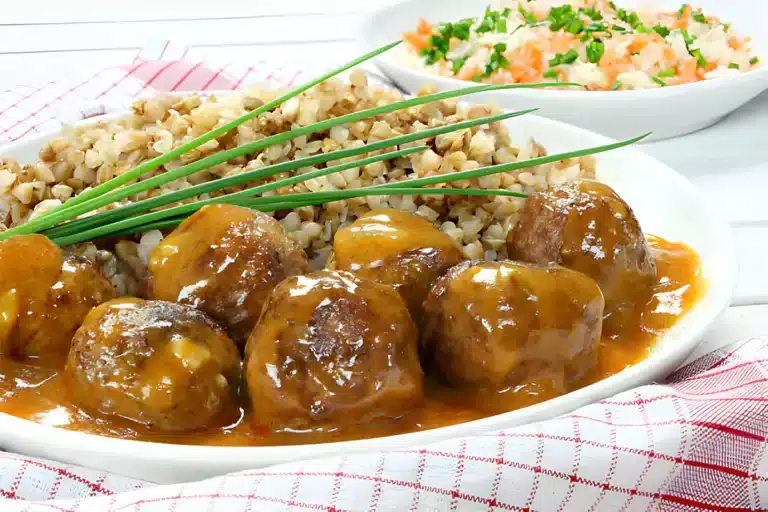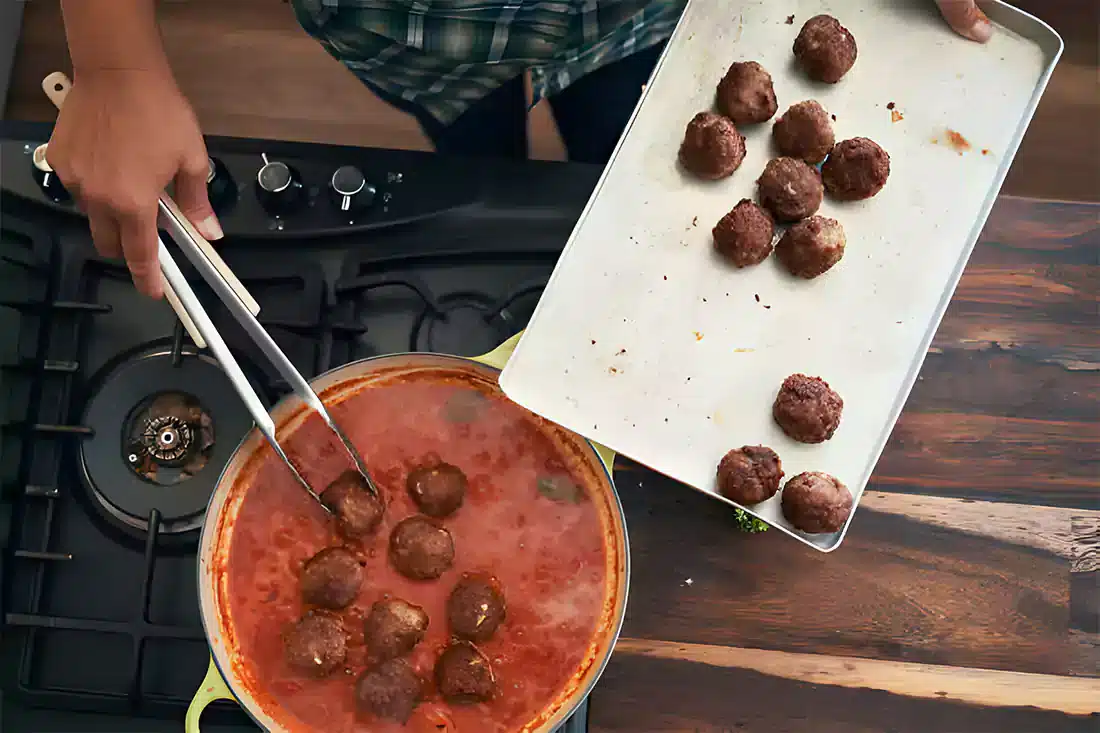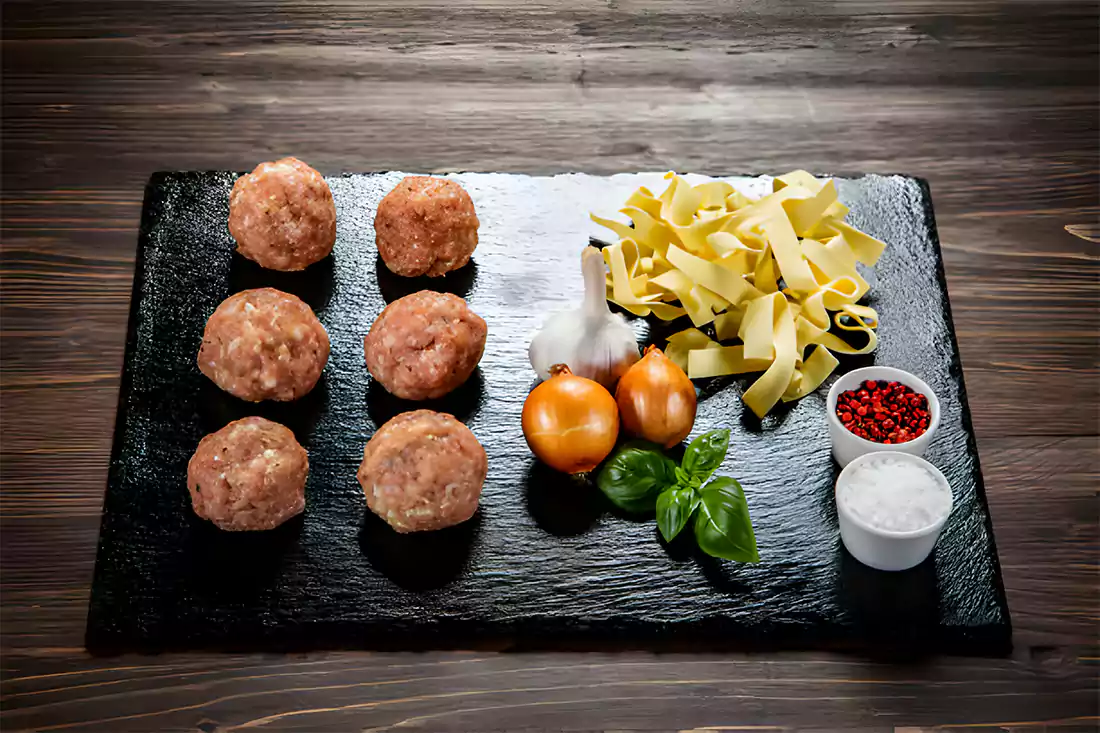Introduction to Porcupine Meatballs
Overview of Porcupine Meatballs
Porcupine meatballs, a quirky name for a dish that’s as fun to eat as it sounds, are a unique twist on the traditional meatball. Unlike their conventional counterparts, these meatballs get their distinctive “spiky” appearance from the grains of rice that protrude from the meat, resembling the quills of a porcupine. Originating from the heart of homey kitchens, this dish has waltzed its way into the hearts of many, becoming a beloved comfort food across various cultures.
The Unique Appeal
The allure of porcupine meatballs isn’t just in their whimsical appearance; it’s also in the delightful texture and flavor that the rice adds to the meat. As the meatballs cook, the rice grains puff up, creating little pockets of tenderness that contrast beautifully with the savory meat. It’s a dance of flavors and textures that can elevate a simple meal to something truly special.
The Challenge of Consistency
But, as with any culinary endeavor, there’s a catch. Sometimes, despite our best efforts, these meaty morsels just don’t hold together. They crumble and fall apart, turning what should be a triumphant meal into a frustrating puzzle of what went wrong. The culprit? Often, it’s the delicate balance of ingredients and technique that tips the scales towards success or disappointment.
In the following sections, we’ll dive deep into the art and science of making perfect porcupine meatballs, much like the comprehensive guide found in Porcupine Meatballs: A Classic Comfort Food Guide. We’ll explore the common pitfalls that lead to their downfall and arm you with the knowledge and skills to ensure your meatballs stay round, proud, and deliciously intact. So, let’s roll up our sleeves and get ready to transform your meatball game!
Common Challenges with Porcupine Meatballs
Understanding Why Meatballs Fall Apart
Ever found yourself staring at a pot of sauce, wondering where you went wrong as your once-perfect porcupine meatballs unravel before your eyes? Well, you’re not alone. This culinary conundrum has puzzled many a home cook. The key to solving this mystery lies in understanding the delicate balance that holds these meaty orbs together.
The Role of Binders
First off, let’s talk about the binders, and for a deeper dive into their role, Taste of Home provides insightful tips on achieving the perfect meatball consistency. These are the unsung heroes of the meatball world, working behind the scenes to keep everything in place. In the realm of porcupine meatballs, the usual suspects like breadcrumbs and eggs play a pivotal role. But here’s the kicker: it’s not just about throwing them into the mix; it’s about striking the perfect balance. Too much breadcrumb, and your meatballs might turn into a crumbly mess. Skimp on it, and they might just fall apart at the slightest touch.
Meat to Binder Ratio
Then there’s the issue of the meat to binder ratio. It’s like a delicate dance, where one wrong step can lead to a culinary faux pas. The type of meat you use can also sway the outcome. Lean meats might make the meatballs too tight and dense, leading to a tough texture, while fattier meats can make them too loose.
Importance of Mixing and Handling
And let’s not forget the mixing and handling part. Overworking the meat can make the meatballs tough, as it develops the proteins too much, making them shrink and squeeze out moisture during cooking. On the other hand, not mixing enough might not distribute the binders evenly, leading to a lack of cohesion.
But fear not, for every problem, there’s a solution, as explored in our detailed Porcupine Meatballs Guide. In the upcoming sections, we’ll delve into the art of choosing the right ingredients, mixing with care, and cooking to perfection. With a bit of knowledge and a sprinkle of patience, you’ll be well on your way to making porcupine meatballs that hold their shape and steal the show. So, stay tuned, as we unravel the secrets to keeping your meatballs together, ensuring each bite is a testament to your culinary finesse.
Ingredients and Their Roles
Key Ingredients for Perfect Porcupine Meatballs
Diving into the world of porcupine meatballs, it’s essential to understand the cast of characters that play pivotal roles in their creation. Each ingredient is not just a part of the recipe; it’s a contributor to the final texture, flavor, and integrity of the meatballs.
Meat Selection and Its Impact on Texture
The choice of meat is the foundation of your meatball masterpiece, and for more insights, check out our Delicious Porcupine Meatballs with Tomato Soup Recipe. While traditional recipes might call for a mix of beef, pork, or veal, each type of meat brings its own texture and fat content to the table. Lean meats, while healthier, can lead to denser meatballs, whereas a higher fat content can provide moisture and tenderness. The trick is to find a balance that suits your taste and dietary preferences, ensuring the meatballs are flavorful yet firm.
Binders: Bread Crumbs, Eggs, and Alternatives
Binders are the glue that holds the meatball universe together, and Food.com explores various options that can add a unique twist to your meatballs. Breadcrumbs absorb moisture, providing structure, while eggs act as a binding agent, ensuring the meat and breadcrumbs meld harmoniously. For those looking to venture beyond traditional breadcrumbs, options like panko, crushed crackers, or even cooked quinoa can offer a unique texture and flavor profile. The key is to ensure the binder is proportionate to the meat, creating a mixture that’s cohesive but not overly dense.
Seasonings and Flavors: Enhancing Taste Without Compromising Structure
The seasonings breathe life into porcupine meatballs, transforming them from mere meat and rice balls into a symphony of flavors. Herbs like parsley, basil, or oregano can add freshness, while spices such as paprika, cumin, or coriander can introduce warmth and depth. Garlic, onions, and grated Parmesan cheese are not just flavor enhancers; they also contribute to the overall texture of the meatballs. However, it’s crucial to balance these elements, as too much moisture from seasonings can affect the meatballs’ ability to hold together.
In the next section, we’ll take these ingredients and embark on the step-by-step journey of preparing porcupine meatballs. From mixing to shaping and cooking, we’ll cover all the bases, ensuring you’re equipped to create meatballs that are not only delicious but also structurally sound. So, grab your apron, and let’s get ready to mix, roll, and cook our way to porcupine meatball perfection!
Step-by-Step Preparation Guide
Preparing the Perfect Porcupine Meatballs
Now that we’ve got our ingredients lined up, it’s time to roll up our sleeves and dive into the nitty-gritty of making those perfect porcupine meatballs, similar to the process outlined in our Ultimate Guide to Moist Bundt Cakes, which emphasizes the importance of ingredient balance. with The Suburban Soapbox offering a step-by-step guide that’s easy to follow. Follow these steps, and you’ll be on your way to a dish that’s sure to impress.
Mixing Ingredients: Techniques to Ensure Even Distribution Without Overworking
- Start with the Binders: In a large bowl, combine your breadcrumbs (or alternative binders) with the eggs. If you’re using soaked breadcrumbs or a panade (breadcrumbs soaked in milk), make sure they’re well-integrated. This mixture will ensure your meatballs are moist and tender.
- Add the Seasonings: Before introducing the meat, mix in your seasonings with the binders. This step helps distribute the flavors evenly, ensuring every bite of your meatball is packed with taste.
- Incorporate the Meat: Gently add your choice of ground meat to the bowl. Using your hands or a fork, lightly mix the ingredients. The key here is to combine everything without overmixing, as this can lead to tough meatballs. Think of it as folding the ingredients together until just combined.
Forming Meatballs: Size, Uniformity, and Handling Tips
- Chill the Mixture: If time allows, chilling the meat mixture for about 30 minutes can make it easier to handle and help the meatballs hold their shape better.
- Portioning: Using a scoop or your hands, portion out the mixture into evenly sized balls. Consistency in size ensures uniform cooking.
- Shaping: Lightly roll the portions between your hands to form balls. If the mixture sticks to your hands, wetting them slightly can help. Remember, gentle handling is crucial to avoid compacting the meat too much.
Cooking Methods: Baking vs. Frying vs. Simmering in Sauce
- Baking: For a healthier option, arrange the meatballs on a lined baking sheet and bake in a preheated oven at 375°F (190°C) until browned and cooked through, about 20-25 minutes. Baking offers a more hands-off approach and can yield a lighter result.
- Frying: To achieve a crispy exterior, heat a thin layer of oil in a skillet and brown the meatballs on all sides. Once browned, they can be finished in the oven or simmered in sauce. Frying adds depth of flavor and texture but is more labor-intensive.
- Simmering in Sauce: For tender, flavorful meatballs, you can simmer them directly in your sauce. This method infuses the sauce into the meatballs and vice versa, creating a harmonious dish. Just be sure to gently place the meatballs in the sauce and avoid stirring until they’ve had time to firm up.
Create perfect porcupine meatballs with ease. Troubleshoot common issues for flawless results.
Troubleshooting Common Issues
Solutions to Prevent Meatballs from Falling Apart
Even with the best intentions and careful preparation, sometimes porcupine meatballs can still fall short of perfection, but our Ultimate Bundt Cake Guide offers tips that are equally applicable to achieving the perfect meatball texture, but Allrecipes community tips might just have the solution you need. But don’t fret! Here, we’ll explore some common pitfalls and how to sidestep them, ensuring your meatballs remain intact and delicious.
Adjusting Binder Content and Types
- If your meatballs are crumbling, it might be a sign that the binder-to-meat ratio is off. Consider increasing the amount of breadcrumbs or eggs in your mixture. Remember, the binder is what helps hold the meatballs together, so it’s crucial to get this balance right.
- Experiment with different types of binders. For instance, if traditional breadcrumbs aren’t doing the trick, try panko for a lighter texture or soaked bread (panade) for added moisture.
Chilling Meatballs Before Cooking
- Never underestimate the power of a good chill. Placing your formed meatballs in the refrigerator for at least 30 minutes before cooking can significantly improve their ability to hold together. The cold helps firm up the fats in the meat, giving the meatballs a better structure.
Cooking Temperatures and Times
- Be mindful of your cooking temperature. If it’s too high, the outside of the meatballs might cook too quickly, causing them to fall apart when you try to turn them or move them. A moderate heat allows the meatballs to cook evenly, ensuring they stay intact.
- Patience is key when cooking meatballs. Give them enough time to form a crust before turning them, especially if you’re frying. This crust helps keep everything together.
Gentle Handling and Cooking
- When mixing your meatball ingredients, use a light touch. Overworking the meat can lead to tough, dense meatballs that are more likely to fall apart.
- If simmering your meatballs in a sauce, resist the urge to stir them too soon. Let them gently simmer until they’re firm enough to withstand a little movement.
By keeping these tips in mind and adjusting your technique as needed, you can troubleshoot common issues and ensure your porcupine meatballs come out perfectly every time. In the next section, we’ll dive into some expert tips and tricks to elevate your meatballs from good to great, adding that extra flair to your culinary creations.
Advanced Tips and Tricks
Expert Tips for Flawless Porcupine Meatballs
Now that we’ve covered the basics and tackled common issues, let’s elevate your porcupine meatball game with some expert tips and tricks, as highlighted by the culinary experts at Taste of Home. These insights will help you add a gourmet touch to your meatballs, ensuring they’re not just intact but irresistibly delicious.
Ingredient Substitutions for Dietary Restrictions
- For those with gluten sensitivities, breadcrumbs can be replaced with gluten-free alternatives like crushed gluten-free crackers or oats. This adjustment ensures everyone can enjoy your meatballs without compromising their dietary needs.
- If you’re catering to a dairy-free diet, skip the cheese and opt for nutritional yeast for a similar cheesy flavor without the dairy.
Flavor Enhancements: Incorporating Herbs and Spices
- Don’t shy away from experimenting with herbs and spices. Fresh herbs like basil, cilantro, or dill can add a vibrant flavor to your meatballs, making them stand out.
- For a spicy kick, consider adding a pinch of red pepper flakes or a dash of hot sauce to the meat mixture. This can add depth and warmth to the meatballs, tantalizing the taste buds.
Presentation and Serving Suggestions
- Think beyond the traditional spaghetti and meatballs. Porcupine meatballs can be a star in a variety of dishes. Serve them with a creamy polenta, a bed of sautéed greens, or even as a standalone appetizer with a dipping sauce.
- Garnish your meatballs with fresh herbs or a sprinkle of grated cheese before serving. This not only adds flavor but also makes the dish visually appealing.
Cooking in Broth for Added Moisture
- For an extra tender meatball, consider simmering your meatballs in a flavorful broth instead of sauce. The broth can infuse the meatballs with moisture and flavor, making them even more succulent.
Resting Meatballs After Cooking
- Allow your meatballs to rest for a few minutes after cooking. This resting period lets the juices redistribute throughout the meatball, ensuring each bite is moist and flavorful.
Enhance your porcupine meatball prep with these expert tips for better taste and presentation. Get answers to FAQs to master meatball making with confidence.
FAQs
Frequently Asked Questions
In our journey to perfect porcupine meatballs, several questions often crop up. Let’s tackle some of the most common queries to round off our comprehensive guide.
How Can I Make My Meatballs Gluten-Free Without Them Falling Apart?
To make gluten-free porcupine meatballs that hold together, opt for gluten-free breadcrumbs or a binder like cooked quinoa, which adds a unique texture and is an excellent gluten-free alternative. Ensure the binder is well-integrated with the meat to maintain the meatballs’ structure.
Can I Make Porcupine Meatballs Ahead of Time?
Absolutely! You can form the meatballs and refrigerate them for up to a day before cooking. Alternatively, you can cook the meatballs completely and freeze them. To reheat, simply thaw and warm them in your sauce, which will also help infuse the meatballs with additional flavor.
What Are the Best Sauces to Pair with Porcupine Meatballs?
Porcupine meatballs are versatile and can pair beautifully with a variety of sauces. A classic tomato-based sauce is always a hit, but don’t be afraid to experiment. A creamy mushroom sauce, a tangy barbecue sauce, or even a spicy Asian-inspired glaze can complement the meatballs wonderfully. The key is to choose a sauce that balances the flavors of the meatballs and enhances the overall dish.
For more insights into crafting the perfect meatball and exploring the science behind it, consider checking out The Science of Cooking Meatballs, which delves into the intricacies of meatball preparation, offering valuable tips and tricks.



